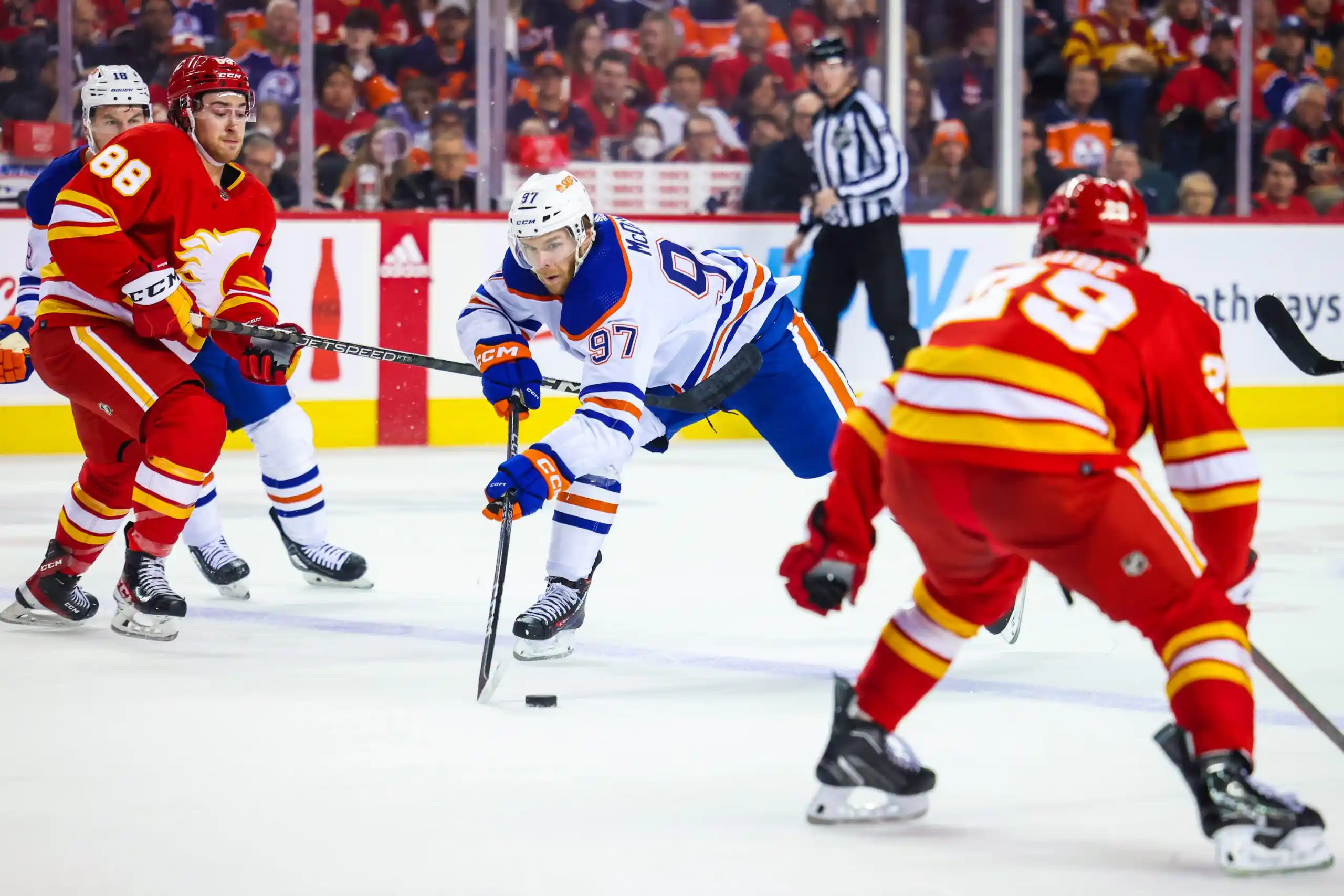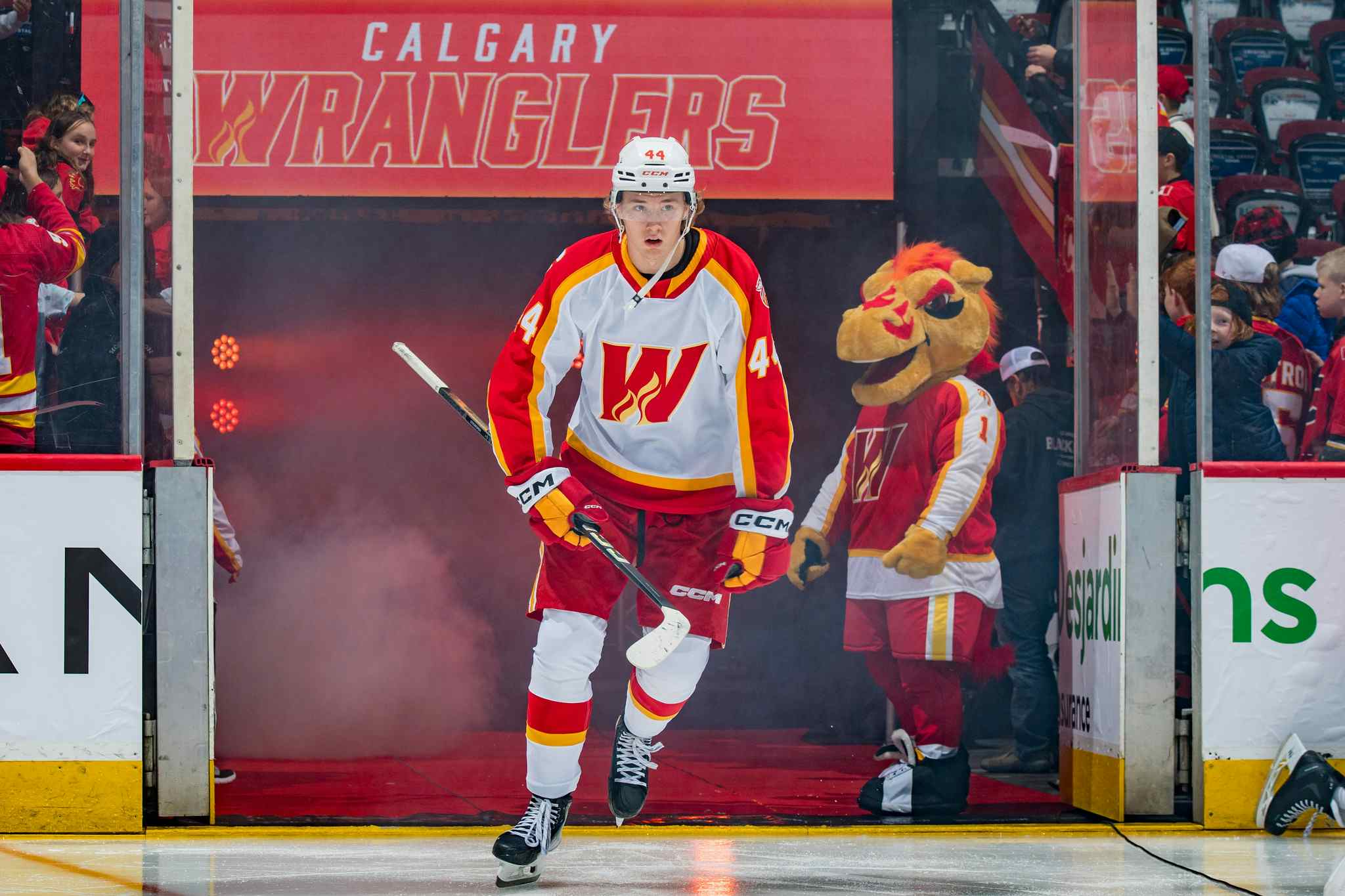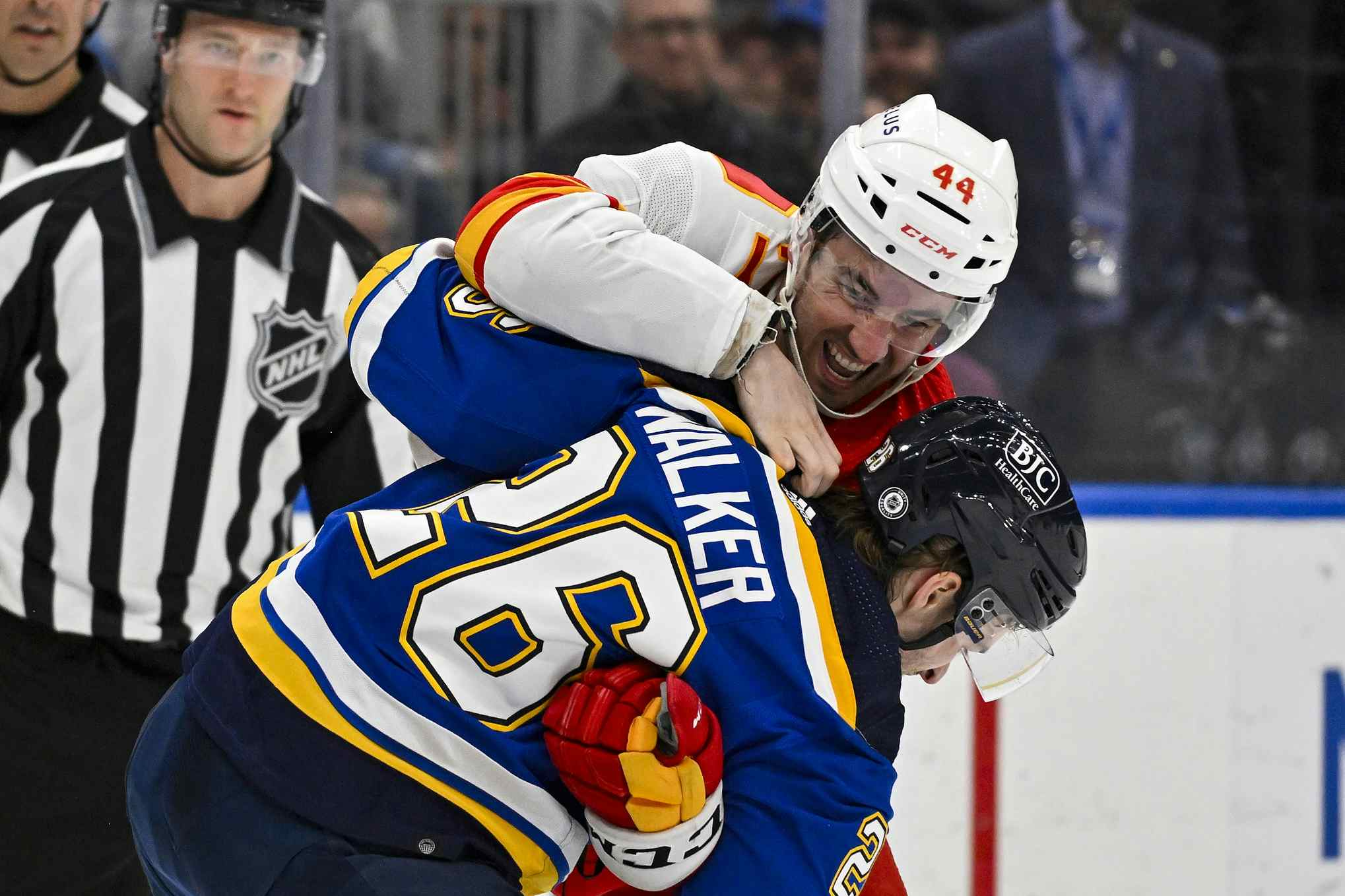Flames Defense – Quantitative Analysis
By Kent Wilson
13 years ago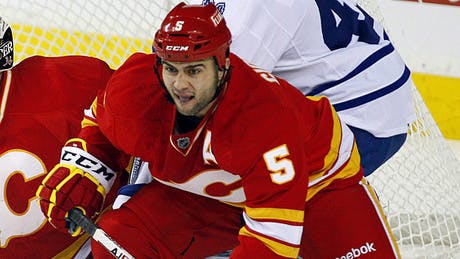
Now that our own Mr. Lambert has shared his defensive player grades, it’s time to go through the back-end and take a closer look at their results this year to better see how they performed and what it might be mean for the club going forward.
Jay Bouwmeester
Advanced Stats:
ESP/60: 0.62 (6th out of 7)
PPP/60: 2.13 (3rd out of 3)
Corsi/60: +0.97 (6th out of 7)
Zone start: 51.7% (3rd toughest out of 7)
Quality of Comp (relative): +1.307 (2nd out of 7)
The numbers bear out what is generally known about Bouwmeester this year (and, indeed since he landed in Calgary): surviving tough circumstances, but certainly not knocking the ball out of the park. Bouwmeester was paired with Regehr almost exclusively and the two of them faced the big boys. Everything about their results given those circumstances are respectable on an absolute level, but not ideal given Bouwmeester’s ticket. At $6.68M, JayBo is the third most expensive defender in the entire NHL behind Zdeno Chara (7.5M) and Brian Campbell (7.14M – yuck). Guys like Niklas Lidstrom, Duncan Keith and Lubomir Visnovsky have cheaper deals and are far more impactful in more or less similar roles.
Where Bouwmeester really falls down amongst such prestigious company is offense. Only Robyn Regehr was less efficient at ES this year than Bouwmeester, and none of the regular blueliners on the Flames PP scored at a lower rate than JayBo. This is the second straight season his offense has fallen way below expectations and it’s not like he can point to poor on-ice SH% as a cause (PDO = 99.5 this year, on-ice SH% of 8.21).
Bouwmeester was usurped by Mark Giordano in terms of first unit PP time this season and it was the right decision by the coaching staff from where I’m sitting: both in terms of the results and in terms of the qualitative play of each guy. Bouwmeester can certainly skate and has some vision, but his shot is mediocre at best and he seems to hesitate far too often to really be effective. Jay’s personal SH% has fallen in the toilet since arriving in town for whatever reason (2.3 and 3.3 each year after averaging 8.2 in the two preceding years in FLA), but so has his shot rate – down from about 182 to about 125 shots per year. You can ascribe that to less PP time and a less forgiving conference if you want – whatever the cause, it’s safe to say he’s probably a 30-35 point defender on the Flames. At best.
As such, Bouwmeester is likely to be a divisive player going forward: he plays on a shut-down pairing in tough circumstances and does alright. He eats up a ton of minutes, he can play at ES and on special teams and he’s incredibly durable. Technically, the Flames are better with him than without him. However, his pretty good play doesn’t seem to justify his elite salary, so unless he can progress from "competent shut-down option" to "dominating all-star" his ticket will be an inefficient one indefinitely.
Robyn Regehr
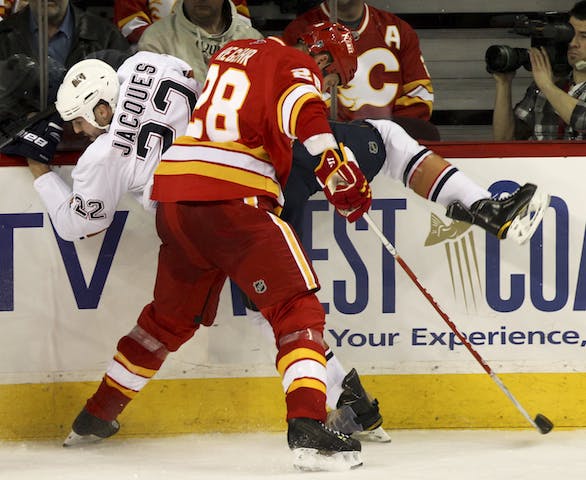
Advanced Stats:
ESP/60: 0.57 (7th out of 7)
Corsi/60: -3.62 (7th out of 7)
Zone Start: 49.9% (2nd toughest out of 7)
Quality of Comp (relative): +1.452 (1st out of 7)
Reggie is a known commodity in town by now: rock solid on the back-end, zero offense. For the nth season in a row, Regehr led the team Flames blueline in terms of quality of competition and difficulty of role. He doesn’t have the requisite puck skills to drive the play north like, say, Visnovsky in Anaheim (thus the marginal possession rating), but the big guy can still limit the damage in the defensive end and make opposing forwards think twice about trying to drive wide on his side of the ice.
That noted, what’s perhaps most disconcerting about Regehr and Bouwmeester (beyond the fact that they merely held their heads above water with a price tag north of $10M) is that the pair of them got positively lit up on the PK this season. The Flames gave up 8.97 SHG/60 with JayBo on the ice (highest on the team) and 7.42 SHG/60 with Regehr (3rd highest) on the ice. To be fair, both guys were the go-to choices to face other teams top PP unit, which is a tough gig. That said, the organization shoould probably expect better than average defensive outcomes for Regehr+Bouwmeester in a setting like the PK given their cumulative price tag and lackluster offensive output.
The good news with Regehr is his contract is far more palatable at about $4M per year. He has two more seasons left on that ticket including next year, so I think the club will have to start making decisions regarding his future with the club sooner rather than later. He’ll be 33-years old when his current deal ends.
Mark Giordano
Advanced Stats:
ESP/60: 0.66 (5th out of 7)
PPP/60: 4.11 (2nd out of 3)
Corsi/60: +8.22 (2nd out of 7)
Zone start: 52.7%
Quality of Comp (relative): +0.172 (4th out of 7)
Don’t let Giordano’s nominal production rate at ES fool you – of all the Flames defenders this season, Gio was plagued with the worst luck. His PDO was a team worst 97.6 and his on-ice SH% at ES was also a team worst 7.75*. This was also the cause of his unappealing plus/minus rating of -8.
*(aside – if you ever wanted proof that a players on-ice percentages are driven more by luck than ability, you only need glance at the Flames back-end numbers this year. Giordano trailed everyone while Steve Staios led the club in both total PDO and on-ice SH%).
On the good side of things, Giordano led all regular Calgary defenders in terms of corsi at +8.22. The only other guy in the same realm was Adam Pardy, and he played less than 40 games in extremely sheltered circumstances (nominal opposition, high zone starts). Giordano has regularly finished amongst the Flames leaders in terms of possession since becoming a regular, although this was the first season he began playing a true top-four role. His ZS ratio remains higher than the shut-down crew (Regehr, Bouwmeester and Sarich) but was well south of the protectables (Staios, Babchuk and Pardy).
In addition, Giordano became a fixture on the Flames first unit PP this season for the first time in his career and he was undeniably beneficial in that role: his production rate was second only to Anton Babchuk and the club’s goals for rate when he was one the ice was a team best 7.56/60.
On the defensive side of things, Giordano emerged as one of the best shot-blockers in the entire league this season with 193 in 82 games (3rd best in the NHL). This is despite spending the second least amount of time in his own end in terms of ES play/60 minutes on the Flames, keep in mind.
Giordano proved he could anchor a second pairing in the NHL this year and produce on the man advantage. He is probably the Flames best shot-blocker and puck mover from the back-end currently and his production will likely improve next year if the bounces start going the other way. Of course, his dollars jump from 892k to 4.02M starting in September, so the team is going to need Giordano to at least sustain his current performance level to make his contract a good value one.
Cory Sarich
ESP/60: 0.82 (4th out of 7)
Corsi/60: +4.60 (3rd out of 7)
Zone start: 49.4% (1st out of 7)
Quality of Comp (relative): +0.236 (3rd out of 7)
By the end of the year, I’d had about enough of Cory Sarich. Ditto Brent Sutter, who dropped Sarich from the second pairing to the third in favor or Brett Carson. With that in mind and despite his obvious gaffes and difficulty with speedy opponents, none of Sarich’s underlying numbers are all that bad. He certainly wasn’t sheltered like Staios et al and Sutter felt comfortable enough with him to start him in the defensive zone more often than not. His production rate is quite decent (although most of his points came from second assist this year) and his corsi rate was acceptable.
The question is: how much of Sarich’s apparent success was driven by Giordano this year? The two mostly played together and there’s little question that Giordano is the superior overall player at this point in their careers. Sarich was a capable shut-down defender once upon a time (which is why Sutter locked him up long-term), but he hasn’t been in that category since the NHL returned from the lock-out. We’ll take a closer look at Sarich’s results with and without Gio last this off-season.
Sarich can still hit like a mack truck and is dependable enough, but doesn’t have the mobility or puck skills to consistently play against top-end offensive players. He’s also prone to poor neutral zone reads now and then. At 32-years old, he’s also not getting any better going forward.
Sarich is in kind of limbo with the Flames: better than the Pardy’s and Staios’ of the world, but no longer an ideal top-four option nor worth his 3.6M price-tag. He’s certainly an NHLer still, but the organizations best option is probably to try to move his contract sooner rather than later. If Sarich stays it won’t be the worst thing in the world, but there’s no question in my mind his dollars could be better spent elsewhere.
Anton Babchuk

ESP/60: 1.07 (1st out of 7)
PPP/60: 4.15 (1st out of 7)
Corsi/60: +3.10 (5th out of 7)
Zone start: 61.9% (7th out of 7)
Quality of competition (relative): -1.51 (6th out of 7)
Babchuk was the proverbial PP specialist for the Flames: ultra-sheltered at ES, but relatively potent when it came to the offensive stuff. Babchuk is plodding and less than graceful, but there’s no arguing his absolute cannon of a point-shot which is by far his best asset. Babs also learned to get in front of pucks a bit in his own end after coming over from CAR – I don’t know if this was simply a skill of his that eventually revealed itself or was an outcome of some coaching by the staff. Whatever the case, it made him slightly less of a detriment in the defensive zone by the end.
That’s the good stuff. On the bad side of the ledger, Babchuk’s corsi rate in light of his circumstances is extremely alarming. Only 8 defenders in the entire league saw a greater than 60% ZS ratio and five of them were either kids or goons (Shattenkirk, Gilroy, Bissonette, Leddy, Brookbank). Of the functional guys who were gifted the high ground, Babchuk had by far the worst possession rate – Brian Campbell was up at +9.84/60 and Christian Ehrhoff managed +11.99/60. Both of them faced better quality players than Babchuk.
Babchuk is a very nice luxury to have on the roster: he can produce, albeit in a very narrow range of circumstances. He’s kind of like a chopped-top roadster with racing tires: great to have when the sun is shining, but not so much when the weather turns.
Babchuk is a pending free agent and the Flames need to tread lightly. His offense from the back-end is a boon, but they’ll still need guys who can do all the heavy lifting so Babchuk can be given the high ground as often as possible. As a result, this isn’t a player you want to break the bank for, either in terms of amount or length. Blueliners who put up nice numbers on the PP tend to get paid as free agents, so it’ll be interesting to see what happens with Babchuk this summer.
Steve Staios
ESP/60: 1.02 (2nd out of 7)
Corsi/60: +3.18 (4th out of 7)
Zone start: 58.2% (5th out of 7)
Quality of competition (relative): -1.232 (5th out of 7)
I noted during the Staios! Is! Available! contest that the old warrior probably didn’t deserve the abuse. His acquisition remains needless and baffling and his cap hit was grossly out of line with his contributions, but in all fairness he wasn’t an Anders Erikssonian disaster this season.
A frequent scratch, Staios only appeared in 39 games for Calgary this year, but as implied he was fairly steady option whenever he made it into the line-up. This is in part because Brent didn’t make some of the incredibly obvious mistakes he made with Staios when he first arrived in town: rather than play him Bouwmeester against a decent level of talent, Staios was limited to third pairing, soft-minutes role as befitting his current skill level. His production rate was high, but an artifact of sample size and those nice percentages I mentioned earlier, so it’s not really indicative of anything in particular. His possession rate was as middling as Babchuk’s in similar circumstances, but that’s all that can be expected of a guy like Staios at this point in his career.
Fun fact – Staios scored 3 goals on just 23 shots this year.
Adam Pardy
ESP/60: 0.88 (3rd out of 7)
Corsi/60: +12.74 (1st out of 7)
Zone start: 59.7% (6th out of 7)
Quality of competition (relative): -1.505 (7th out of 7)
A tough season for Adam who only appeared in just 30 contests due to various long-term injuries. His results were alright when he was in the line-up though: like Babchuk and Staios, Pardy was part of the sheltered brigade, so he faced the 3rd and 4th liners while starting more often in the offensive end. Unlike Babchuk and Staios, though, Pardy managed a possession rate more…appropriate to his easy minutes. This isn’t anything new for Pardy, who has played in a similar role the last couple of years and managed similar underlying numbers.
It’s doubtful that Adam will ever grow beyond the competent third pairing guy he is now. That said, he’s a known commodity who should come cheap and has proven he can pretty much hold his own at the bottom-end of the rotation. He’s also young enough that it’s unlikely he’ll fall off a cliff any time soon (assuming he can get over his injury problems, of course). It won’t be a terrible shame if the Flames let him walk as an unrestricted free agent this summer because third pairing defenders are relatively easy to replace, but he could probably be had for a a few dollars above minimum wage and there likely worse ways to spend money in the open market.
Recent articles from Kent Wilson


